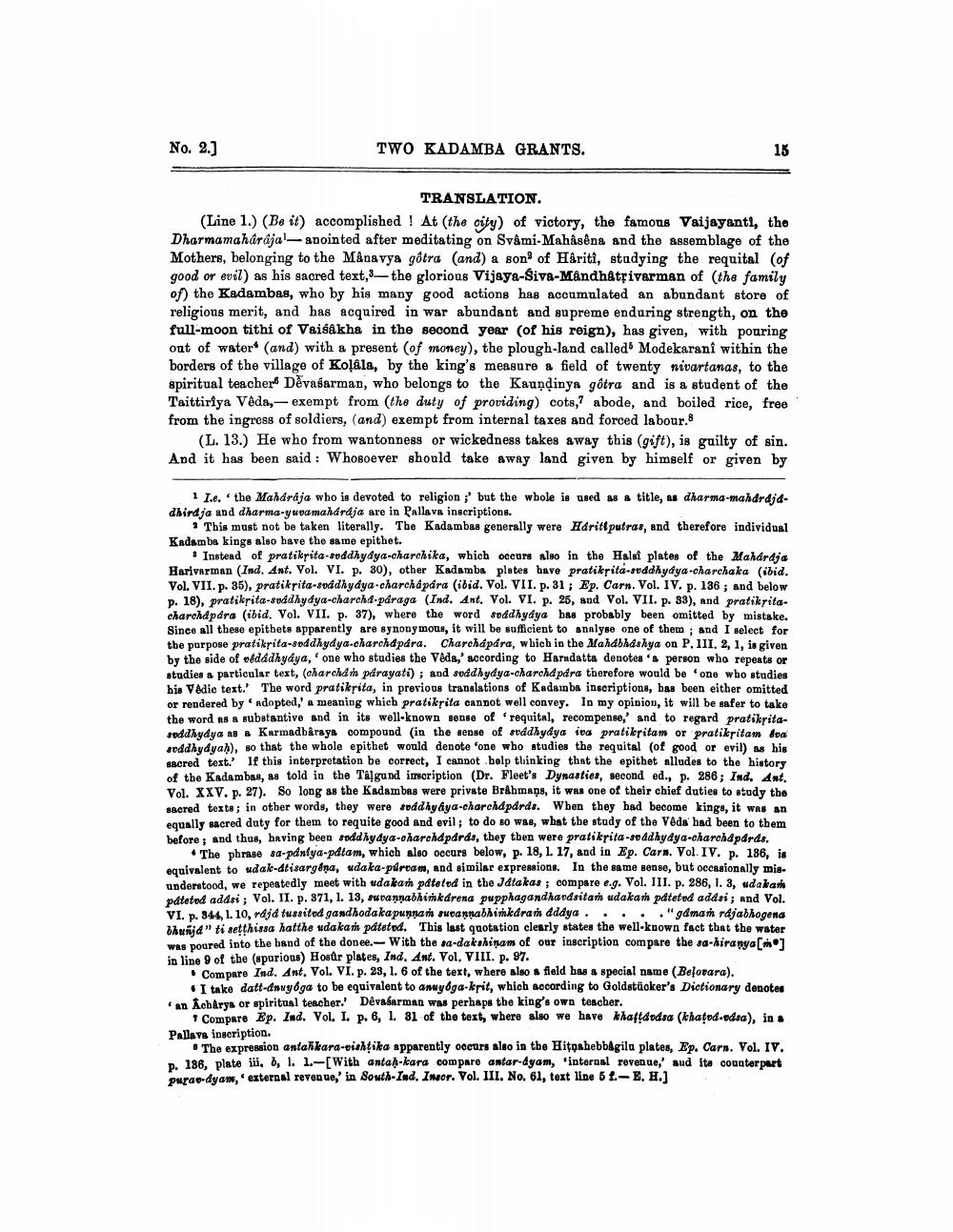________________
No. 2.]
TWO KADAMBA GRANTS.
15
TRANSLATION.
(Line 1.) (Be it) accomplished! At (the city) of victory, the famous Vaijayanti, the Dharmamaharaja-anointed after meditating on Svâmi-Mahâsêna and the assemblage of the Mothers, belonging to the Mânavya gôtra (and) a son of Hâriti, studying the requital (of good or evil) as his sacred text,3-the glorious Vijaya-Siva-Mandhâtrivarman of (the family of) the Kadambas, who by his many good actions has accumulated an abundant store of religious merit, and has acquired in war abundant and supreme enduring strength, on the full-moon tithi of Vaisakha in the second year (of his reign), has given, with pouring out of water (and) with a present (of money), the plough-land called Modekaranî within the borders of the village of Kolâla, by the king's measure a field of twenty nivartanas, to the spiritual teacher Devasarman, who belongs to the Kaundinya gôtra and is a student of the Taittiriya Vêda,-exempt from (the duty of providing) cots, abode, and boiled rice, free from the ingress of soldiers, (and) exempt from internal taxes and forced labour.8
(L. 13.) He who from wantonness or wickedness takes away this (gift), is guilty of sin. And it has been said: Whosoever should take away land given by himself or given by
1 I.e. the Maharaja who is devoted to religion; but the whole is used as a title, as dharma-mahdrájadhiraja and dharma-yuvamahárája are in Pallava inscriptions.
This must not be taken literally. The Kadambas generally were Hdrittputras, and therefore individual Kadamba kings also have the same epithet.
Instead of pratikrita-svadhyaya-charchika, which occurs also in the Halsi plates of the Maharaja Harivarman (Ind. Ant. Vol. VI. p. 30), other Kadamba plates have pratikrita-svadhyaya-charchaka (ibid. Vol. VII. p. 35), pratikrita-svadhyaya-charchápára (ibid. Vol. VII. p. 31; Ep. Carn. Vol. IV. p. 136; and below p. 18), pratikṛita-svádhyaya-charcha-paraga (Ind. Ant. Vol. VI. p. 25, and Vol. VII. p. 33), and pratikritacharchápára (ibid. Vol. VII. p. 37), where the word svádhyaya has probably been omitted by mistake. Since all these epithets apparently are synonymous, it will be sufficient to analyse one of them; and I select for the purpose pratikrita-soddhydya-charchápára. Charchápára, which in the Mahabhashya on P. III. 2, 1, is given by the side of védádhyaya, ' one who studies the Veda,' according to Haradatta denotes a person who repeats or studies a particular text, (charcham párayati); and svádhydya-charchápára therefore would be 'one who studies his Vêdic text. The word pratikrita, in previous translations of Kadamba inscriptions, has been either omitted or rendered by adopted,' a meaning which pratikrita cannot well convey. In my opinion, it will be safer to take the word as a substantive and in its well-known sense of requital, recompense,' and to regard pratikritasoddhydya as a Karmadbâraya compound (in the sense of svádhydya iva pratikritam or pratikritam va svddhydyah), so that the whole epithet would denote 'one who studies the requital (of good or evil) as his sacred text. If this interpretation be correct, I cannot help thinking that the epithet alludes to the history of the Kadambas, as told in the Talgund inscription (Dr. Fleet's Dynasties, second ed., p. 286; Ind. Ant. Vol. XXV. p. 27). So long as the Kadambas were private Brahmans, it was one of their chief duties to study the sacred texts; in other words, they were seádhyaya-charchápárds. When they had become kings, it was an equally sacred duty for them to requite good and evil; to do so was, what the study of the Vêda had been to them before; and thus, having been soddhydya-charchdpdrds, they then were pratikrita-svádhyaya-charchápárás.
The phrase sa-padniya-pdtam, which also occurs below, p. 18, 1. 17, and in Ep. Carn. Vol. IV. p. 186, is equivalent to udak-dtisargéna, udaka-pártam, and similar expressions. In the same sense, but occasionally misunderstood, we repeatedly meet with udakam pateted in the Jatakas; compare e.g. Vol. III. p. 286, 1. 3, udakam páteted adási; Vol. II. p. 371, 1. 13, suvannabhimkárena pupphagandhavdsitam udakam pateted addsi; and Vol. VI. p. 344, 1. 10, rajd tussited gandhodakapunnam suvannabhimkáram adaya. "gamam rajabhogena bhunjd" ti setthissa hatthe udakam pateted. This last quotation clearly states the well-known fact that the water was poured into the band of the donee. With the sa-dakshinam of our inscription compare the sa-hiranya [m] in line 9 of the (spurious) Hosûr plates, Ind. Ant. Vol. VIII. p. 97.
Compare Ind. Ant. Vol. VI. p. 23, 1. 6 of the text, where also a field has a special name (Belovara).
I take datt-dnuyoga to be equivalent to anuyoga-krit, which according to Goldstücker's Dictionary denotes an Acharya or spiritual teacher.' Dêvasarman was perhaps the king's own teacher.
7 Compare Ep. Ind. Vol. I. p. 6, 1. 31 of the text, where also we have khafṭdvdsa (khaṭvá-vása), in a Pallava inscription.
The expression antaħkara-vishṭika apparently occurs also in the Hitpahebbâgilu plates, Ep. Carn. Vol. IV. p. 186, plate iii. 6, 1. 1.-[With antah-kara compare antar-ayam, 'internal revenue,' and its counterpart purae-dyam, external revenue,' in South-Ind. Insor. Vol. III. No. 61, text line 5 f.-E. H.]




